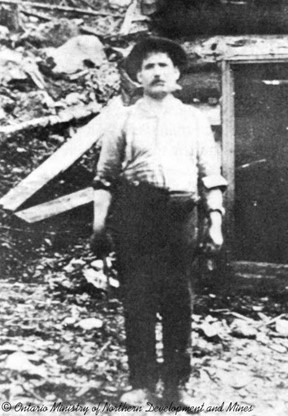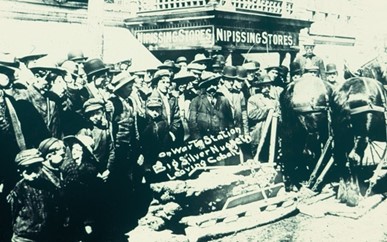Follow the 4 Lessons of the Silver-Finding Fox
Happy Thanksgiving to those of you living in the United States. The U.S. markets are closed due to the holiday today, so I thought I’d take a moment to step back from the recent volatility and share some investment lessons I’ve learned.
Best part, these lessons come from a story that combines two of my favorite topics: history and gold.
The histories of North America’s rushes for gold and silver are filled with outrageous stories and larger-than-life characters. And here’s one you haven’t heard before: A massive silver rush … that was started by a wild fox.
It’s an incredible tale ripped from the pages from history. But it holds lessons for today’s investors.
Let me tell you the tale, and you be the judge. It’s the story of how silver was discovered in Canada.
What Happened After the Gold Miners Struck It Rich … Or Busted
The story begins after the fabled gold rush in the Cariboo, when the gold miners struck it rich, went home busted, or both.
There’s some dispute about what happened next. But one fact everyone can agree on is that Canada’s big silver deposits weren’t discovered until 1903.

That’s when Fred LaRose, a blacksmith working at his forge in the far reaches of Northern Ontario, was being continually bothered by a fox.
Foxes aren’t rare in that part of Canada — they’re about as common as weasels, but with big fluffy tails and better publicists. Usually, though, foxes are smart enough to stay away from people. This darned fox kept coming close — too close.
Fred’s short temper flared hotter than the iron he was working … now he could see the fox’s beady eyes staring at him from a bush. He turned and hurled his hammer at the critter. He missed the fox and went to retrieve his hammer. Behind the bushes, he found his hammer alright. But he also found a glittering vein of ore thrusting right through the surface of the rock.
Fred didn’t know it was silver at first. He showed a sample to the owner of the Matabanick Hotel in Haileybury, Ontario, telling him that the rock seemed to contain “some kind of damned metal.” The hotel owner then showed the rock to T.W. Gibson, the director of Canada’s Bureau of Mines. Gibson’s conclusion: The rock contained niccolite (nickel-rich ore).
As often happens in these stories, the experts were wrong.
Still, by 1903, nickel was worth something. So, Gibson forwarded the sample to Ontario’s official geologist, Willet Green Miller, who passed it along to Ontario’s assayer, A.G. Burrows. Burrows looked at the rock and pronounced it silver.
Miller trucked on out to Fred’s camp and saw that there were indeed big veins of ore and chunks of metal just lying scattered around! It was promising enough that he came back with two assistants to do a full geological survey.
Miller wrote in his report of “pieces of native silver as big as stove lids or cannon balls lying on the ground, as well as cobalt bloom and niccolite.”
The cobalt captured his fancy. So, near the ore deposit, by the railroad line on the shore of Long Lake, he set up a sign reading: “Cobalt Station.”
And that’s how Canada’s silver town became known as Cobalt Station. Where the miner’s pick-ax struck, Cobalt Station sprang into existence out of the wilderness.
But let’s not forget Fred LaRose, the hot-tempered blacksmith. Unlike many early gold and silver prospectors, Fred didn’t miss out. He staked out his LaRose Mine and sold half of it to investors led by two brothers, Noah and Henry Timmins, who became big names in Canadian silver.
LaRose sold half his stake for $3,500, a large sum in 1903. A lawyer managed to snag another 20%. Finally, the Timmins boys bought the rest of LaRose’s stake for $25,000, an even larger sum.
But the brothers got a bargain. The LaRose mine went on to produce over 25 million ounces of silver.
Others arrived to make their fortunes. A man named Tom Hebert discovered what later became the Nipissing Mine. More than half a million dollars’ worth of silver was dug out of a single vein.
Two Discoveries in One Week!
Another man, William G. Trethewey, arrived all the way from Cornwall, Britain. On his second day in the area, he found a rich deposit that became the Trethewey Mine.
He staked his claim, then moved a short distance away and found what would become another mine, the Coniagas. The silver pulled from that mine was described as “consisting of slabs of native metal stripped off the walls of the vein like boards from a barn.”
Most prospectors spend their entire lives without finding a single worthwhile mine … but Trethewey found two of the richest silver mines in Canada’s history in one week.
On and on they came. LaRose’s hammer toss launched a hundred mines. Most ran out quickly, but by the end of 1905, there were 15 mines in operation. In the first 60 years of their active life, the mines of the Cobalt camp shipped a total of nearly 1,185,000 metric tons of rich silver ore and concentrates. The total production exceeded 420,500,000 ounces of pure silver. At today’s prices, that’s over $33.6 billion worth of the precious metal.
As always seems to happen, the boom was followed by a bust, and in the end, the only thing Cobalt Station was rich in was history.
Lessons Never to Be Forgotten
Lesson 1. Don’t underestimate the potential value of a great discovery, no matter how accidental it may be.
I made one of my best silver “discoveries” in the green room of a Canadian broadcaster. It was there that I ran into a silver company’s chief executive quite by accident. His story was so compelling I just couldn’t break away.
I went down to visit the mine, and came back with an investable story. And my subscribers made a wagon-load of money.
Lesson 2. Don’t always believe the so-called “experts.”
Sometimes your gut feeling and intuition are more accurate. Most of Wall Street, for instance, has been consistently wrong about silver for years. They didn’t see the turnarounds coming in gold, oil or base metals, either.
Lesson 3. Don’t expect every prospect to turn into a winner.
Sometimes, stories are too good to be true. When a guy tells me he has a prospect north of the Arctic Circle, that he’s finding diamonds as big as his fist, that he’s got gold nuggets the size of his head, and all he needs is $10 million to develop it properly, I smile, nod and cross him off my list. Those are the easy ones to discard.
Other times, it’s not so easy to spot the losers. Management may be sharp. They may even have plenty of money in the bank. But something goes wrong. Why? Because management has no track record … or the numbers in their financial statements just don’t add up … or I myself miss something. That can happen too.
Lesson 4. Avoid the easy-come-easy-go syndrome.
Too many people who get rich quick get poor again quicker. That’s why it’s smart to take some money off the table when positions run up quickly. Bulls and bears make money. Chickens can too. It’s the pigs that get slaughtered.
Keep these lessons in mind as we go forward in what could turn out to be the greatest bull market for precious metals of all time.
After all, you never know when a stray fox will change your luck next.
All the best,
Sean




